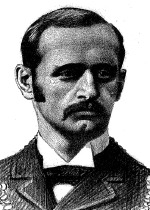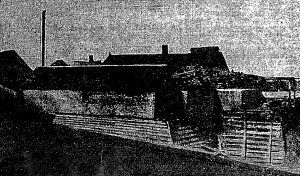
Rev. P.F. Jernegan
In late 1896, Rev. Prescott Ford Jernegan, pastor of a Baptist church in Middletown, Connecticut, approached the jeweler Arthur Ryan with a novel proposition. Jernegan claimed to have invented a method of cheaply extracting gold from sea water. He said that the technique had been revealed to him in a heavenly vision. He offered to let Ryan test his invention and, if suitably impressed, join him in establishing a company to profit from the discovery.
Jernegan called his device the Gold Accumulator. It consisted of a wooden box with holes cut through it to allow the free passage of water. Inside the box was a pan of mercury mixed with a secret ingredient. An electric current ran into the mercury via a wire attached to a small battery. The entire contraption was supposed to be lowered into the water and left overnight. The electrified mercury mixture would then suck precious metals out of the water. When raised in the morning, there would be gold.
Ryan agreed to test the invention. To guarantee no trickery, Jernegan declared that he wouldn't even be present during the test. He simply gave Ryan the device and told him how to use it.
Gold in Sea Water
The presence of gold in sea water had been discovered by the British chemist Edward Sonstadt in 1872. He estimated there was approximately one grain of gold in every ton of water. This was later confirmed by the Australian chemist Archibald Liversidge who further estimated there was $48,000,000,000,000 worth of gold in the oceans.
These facts were widely known by 1896, but it was believed that the expense of extracting gold from sea water made the oceans an unprofitable source of the metal. However, it seemed plausible that Jernegan might have found a solution to this problem.
The Electrolytic Marine Salts Company

Original plant of the Electrolytic Marine Salts Company
Ryan conducted the test of Jernegan's Gold Accumulator in February 1897 on a wharf outside of Providence, Rhode Island. He brought several colleagues with him. Together they lowered the gold accumulator into the water and waited overnight, huddled in a frame shanty on the end of the wharf. When they raised the Accumulator in the morning they examined the mercury mixture and saw bright flakes of gold embedded in it.
An assayer estimated the gold to be worth $4.50 (about $100 in 2007 dollars). Not much, but when they multiplied this by 1000, which was the number of accumulators Jernegan said it would be possible to build within the year, considered that the machines would be running day and night, and factored in the negligible expense of operating the accumulators, they quickly saw the potential of the invention.
Jernegan, Ryan, and a team of investors founded the Electrolytic Marine Salts Company later that year. They chose to build their first gold accumulation factory in Lubec, Maine. This site was chosen both for its secluded location and because of the tides there that rose and fell 20 feet every day, aiding the efficiency of the accumulators. They also opened a business office in Boston.
Within a few months, several accumulators were producing $145 of gold a day. To raise money for expansion, the company's board of directors decided to offer shares on the market. They floated the stock at $33 a share, and within weeks it had risen to $150.
The Scam Revealed
Everything seemed to be going well. The company was making plans to increase the number of accumulators. The investors were counting their profits. And then in July 1898, Jernegan disappeared.
It was discovered he had fled to Europe under an assumed name. Also gone was his mysterious assistant, Charles Fisher, a man who had shunned attention, allowing Jernegan to be the public face of the company.
As soon as Jernegan and Fisher were gone, the gold accumulators stopped working. No more gold came up from the ocean depths. The company's investors soon realized that the secret ingredient necessary to make the accumulators work was Fisher.
Fisher was a trained diver. During the initial test of the accumulator he had swum underwater from shore in his diving suit, located the gold accumulator, and substituted the mercury for a mixture of his own, mixed with gold. Later, he had purchased gold bars in Boston and transported them up to Lubec, where they were presented to investors as the weekly yield.
When plans were made to increase the number of accumulators, Fisher and Jernegan had decided to take their money (estimated at $200,000 each) and run. The two men were never caught.
In a surprise move, Jernegan later refunded $75,000 of the money he had stolen, leading to speculation that Fisher was the ringleader of the scheme.
The last that was ever heard of Jernegan, he had moved to the Philippines where he was working as a school teacher.
Links and References
- "Directors Charge a Conspiracy." (Aug 2, 1898). Chicago Daily Tribune.
- Rigby, Cora. (May 16, 1915). "Lure of Easy Money: Rev. P.F. Jernegan's Scheme to Extract Gold from Sea Water." The Washington Post.
- "Gold from the Sea". (Aug 13, 1898). Scientific American. 79(7): 99.



Comments
The trick requires two people. One - Jernegan - to talk to the punter, and to be seen obviously not interfering with the experiment. He can be either present at the test site or safely somewhere else, as long as he is plainly not suspected of fiddling with the set-up. The second man - Fisher - is needed to stay out of the limelight, unknown to the punters, and secretly do the fiddling so that nr. one can remain unsuspected.